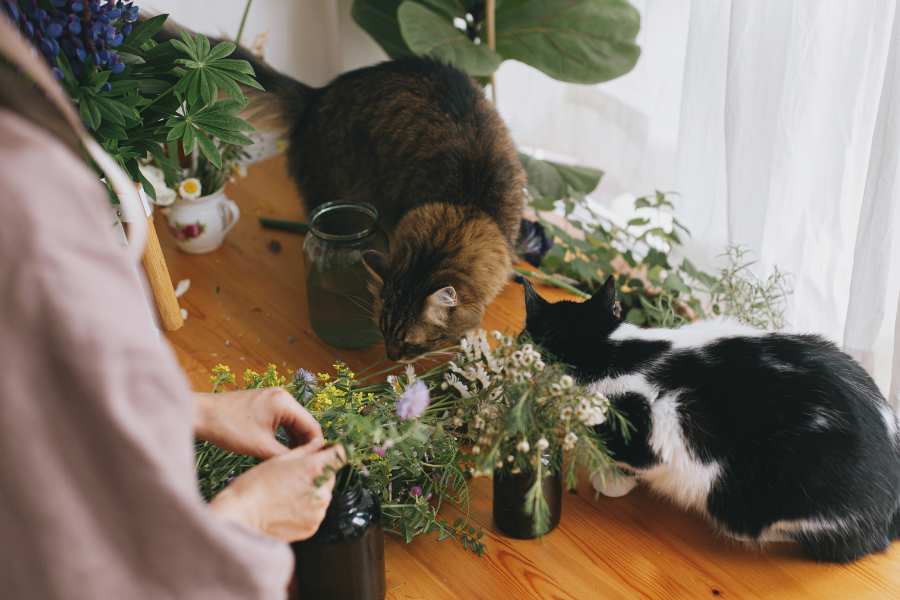Understanding Plant Toxicity in Pets
Cats and dogs explore the world with their noses and mouths. Many indoor and outdoor plants contain compounds that can irritate the mouth or stomach, or even damage internal organs if eaten.
Common toxic reactions include:
- Drooling or vomiting
- Diarrhoea
- Lethargy or disorientation
- Difficulty breathing
- Skin irritation or swelling of the mouth
If you suspect your pet has eaten a harmful plant, contact your vet immediately and, if possible, take a sample of the plant with you.
Plants Harmful to Dogs
Some garden favourites and indoor greens can be surprisingly dangerous for dogs.
1. Peace Lily (Spathiphyllum)
You might love their glossy leaves and elegant white blooms, but are spathiphyllum poisonous to dogs? Unfortunately, yes. Peace lilies contain calcium oxalate crystals that cause mouth pain, drooling, and vomiting if chewed. Dogs that like to chew leaves or flowers should be kept away from them entirely.
2. Aloe Vera
It’s soothing for human skin but is aloe dangerous for dogs? Yes. The gel inside may be safe when processed, but the outer sap (aloin) can cause vomiting, diarrhoea, and lethargy in dogs. Keep aloe plants out of reach — or choose pet-safe succulents like haworthia instead.
3. Jasmine
Many Kiwis love jasmine for its fragrance, but is jasmine toxic to dogs? The answer depends on the variety. True jasmine (Jasminum officinale) is usually non-toxic, but plants like “Carolina jasmine” (Gelsemium) are highly poisonous, causing muscle weakness, seizures, or even respiratory issues. When in doubt, avoid planting jasmine where your dog roams.
4. Coral Bells (Heuchera)
Known for their vibrant foliage, these perennials can be risky. Are coral bells toxic to dogs? Yes, they can irritate the stomach and cause vomiting if eaten in large amounts. Dogs with a habit of grazing on garden plants are particularly vulnerable.
5. Sago Palm
This tropical-looking plant is one of the most dangerous plants harmful to dogs. Every part, especially the seeds, contains cycasin — a toxin that can lead to severe liver damage and even death.
Tip: For more safety advice, read Five Tips for Keeping Your Dog Safe — a quick guide to recognising hazards around your garden and home.
Dog-Safe Alternatives
Consider dog-friendly options like spider plants, Boston ferns, or marigolds. These add greenery without the worry.
Plants Poisonous to Cats
Cats are more sensitive than dogs to plant toxins, and their natural curiosity often draws them to chew leaves or bat at flowers. Here are some of the most common plants poisonous to cats:
1. Lilies (Lilium species)
All true lilies — including tiger, day, Easter, and Asiatic lilies — are deadly to cats. Even a few grains of pollen or a sip of water from a lily vase can cause kidney failure.
Many NZ households display lilies during holidays or as gifts. If you have cats, avoid bringing lilies into your home altogether.
2. Peace Lily (Spathiphyllum)
You might wonder, are peace lily poisonous to cats? Yes — and they’re also often mistaken for true lilies. Peace lilies can cause oral pain, drooling, and difficulty swallowing. While rarely fatal, they can make your cat very unwell.
3. Spathiphyllum and Cats
Because Spathiphyllum is the scientific name for peace lilies, it’s worth clarifying: are spathiphyllum poisonous to cats? Absolutely. Even brushing against the leaves and then grooming can transfer the irritant crystals.
4. Flowers Poisonous to Cats
Many cut flowers can pose risks — including tulips, daffodils, chrysanthemums, and azaleas. If you love floral arrangements, opt for cat-safe blooms such as roses, orchids, or gerberas.
5. Toxic Houseplants for Cats
Common indoor plants that may surprise you include:
- Dieffenbachia (Dumb Cane): Causes severe oral irritation.
- Pothos (Devil’s Ivy): Leads to drooling and vomiting.
- Philodendron: Another calcium oxalate producer — very common and very irritating.
- Snake Plant: Can cause mild nausea and vomiting.
For more cat-care guidance, see Tips for Keeping Your Indoor Cat Stimulated — it’s full of ideas for safe, plant-free enrichment.
What to Do If Your Pet Eats a Toxic Plant
- Stay calm and act quickly. Panicking may distress your pet further.
- Remove access. Take away any remaining plant material to prevent more ingestion.
- Check symptoms. Note drooling, vomiting, or unusual behaviour.
- Call your vet immediately. Describe what your pet ate and bring a sample or a photo of the plant.
- Do not try home remedies. Never induce vomiting or give milk without veterinary advice.
If your pet receives emergency treatment, Pet-n-Sur’s Pet Insurance can help cover costs related to poisoning, diagnostics, and aftercare.
Creating a Safe, Pet-Friendly Home
Prevention is easier — and cheaper — than emergency treatment. Here’s how to keep your home and garden safe:
1. Identify Your Plants
Before bringing home a new plant, look up whether it’s among the toxic houseplants for cats or plants harmful to dogs. Apps like “PictureThis” or “PlantNet” can help you identify species instantly.
2. Keep Risky Plants Out of Reach
Hang plants high, use shelves or macrame hangers, and consider closed terrariums for decorative greens.
3. Train and Distract
Provide your pets with safe chew toys or cat grass to reduce temptation.
4. Choose Pet-Safe Substitutes
Pet-friendly favourites include:
- For Dogs: Areca palm, ferns, orchids, and rosemary.
- For Cats: Calathea, bamboo palm, and African violet.
5. Regular Check-Ups
Routine vet visits can catch early signs of toxicity or digestive irritation. Our Preventative Pet Care article explains how regular monitoring keeps your pet healthy and protected.
How Pet Insurance Supports Plant Safety
Even with the best intentions, accidents can happen. A knocked-over plant, a stray leaf, or a curious lick can turn into an expensive emergency. That’s where Pet-n-Sur steps in.
With flexible coverage options, Pet Insurance plans help you manage costs for:
- Emergency vet visits
- Toxicity treatment and recovery care
- Ongoing medication or monitoring
- Diagnostic tests and imaging
For dog owners, our Dog Insurance includes coverage for breed-related conditions and respiratory issues — ensuring your pup gets the care it needs, even beyond plant exposure.
Learn how proactive protection saves both stress and money in How Preventative Care for Pets Can Save You Money.
Final Thoughts
Houseplants and pets can coexist safely with awareness and care. By recognising plants harmful to dogs and plants poisonous to cats, you’re already taking a big step toward a safer, healthier home.
At Pet-n-Sur, we’re here to support you — from prevention to protection. Whether it’s understanding are peace lily poisonous to cats or choosing pet-safe greens, our goal is to give every New Zealand pet parent peace of mind.
Explore your options today with Pet-n-Sur Pet Insurance — because accidents happen, but worry doesn’t have to.



